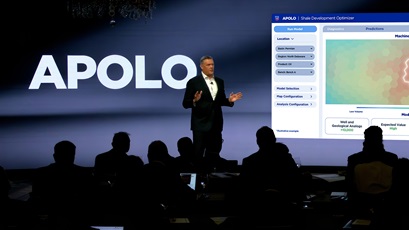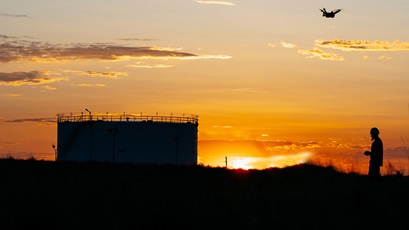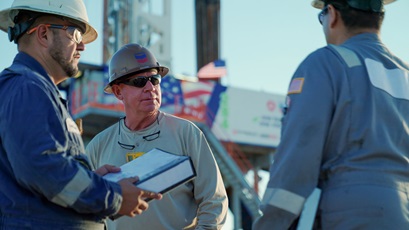our operations
bayou bend project aims to advance carbon dioxide storage along the US gulf coast
2 min read | june 30, 2025
The joint venture is intended to help critical industries in the area lower the carbon intensity of their operations.
A rig drilled an offshore stratigraphic well that gathered data to help bolster understanding of the Bayou Bend project’s subsurface storage location.
Jay LeJeune likes a challenge. That’s why he signed up to be part of the Bayou Bend CCS LLC (Bayou Bend) team.
Bayou Bend, a joint venture between Chevron, Equinor and TotalEnergies SE, is a carbon dioxide (CO2) transportation and storage project in Southeast Texas. It aims to help industries in the region make strides toward their lower carbon goals.
The team has already reached key milestones including drilling the project’s onshore and offshore stratigraphic wells. These wells supplied key data about the subsurface area—data that’s helpful in determining whether the conditions are right for storing CO2. The intent is for Bayou Bend to be a hub of CO2 storage for industries in the area.
“It’s exciting to use our expertise in areas where we have a longstanding history of helping industries and customers that use our products. We’re leveraging proven methods that have the potential to make a positive impact at scale,” said LeJeune, Chevron’s commercial advisor for the Bayou Bend project. “Carbon capture, utilization and storage (CCUS) is a tool in the toolkit to support U.S. energy competitiveness.”
bringing chevron expertise to carbon storage
Bayou Bend is an approximately 140,000-acre onshore and offshore project positioned along the U.S. Gulf Coast and operated by Chevron. LeJeune noted that experience matters when you’re developing a project like this.

“I was drawn to this project because Chevron knows wells and pipelines,” LeJeune said. “It’s an exciting time to see our more than 140 years of expertise and technology supporting a region that supplies so many critical products and jobs.”
With its mix of industrial activity, the right geology, infrastructure and workforce, Southeast Texas is a prime location for a carbon capture and storage (CCS) project. The growing CCS industry could help drive economic growth, attract investment and create jobs. It could also allow the region to be a leader in both energy and environmental innovation.

Another rig drilled an onshore stratigraphic well to gather more information about Bayou Bend’s underground storage site.
what’s next for bayou bend
In 2024, Bayou Bend reached another milestone: The project submitted a permit application for CO2 injection. The approval process usually takes the regulatory agency about two years. An approved permit means that the project satisfies government requirements designed to protect public health and underground sources of drinking water.
There is still more work to do before injecting CO2 into the project’s storage sites. The team must complete the design, engineering and building of facilities and supporting infrastructure. Wells for storage will need to be drilled, and the monitoring program must be implemented.
“No one country, no one company, no one industry acting alone can meet the world’s energy and climate ambitions,” said Chris Powers, Chevron’s vice president of CCUS & Emerging. “Bayou Bend seeks to play a key role in supporting those goals. Our project is well-positioned to support multiple industries in their ambitions to lower carbon intensity and continue the positive economic impact of these industries along the U.S. Gulf Coast.”
topics covered
related content
-

 how APOLO helps chevron pinpoint prime drilling locations
how APOLO helps chevron pinpoint prime drilling locationsour operationsnovember 12, 2025
-

 robotics supports more efficient workplace
robotics supports more efficient workplaceour operationsnovember 10, 2025
-

 the people who power the US energy advantage
the people who power the US energy advantageour operationsnovember 06, 2025
-

 a statement from chevron CEO mike wirth on Argentina
a statement from chevron CEO mike wirth on Argentinaour operationsseptember 24, 2025
chevron email updates
Subscribe to our newsletter to receive news and updates.



